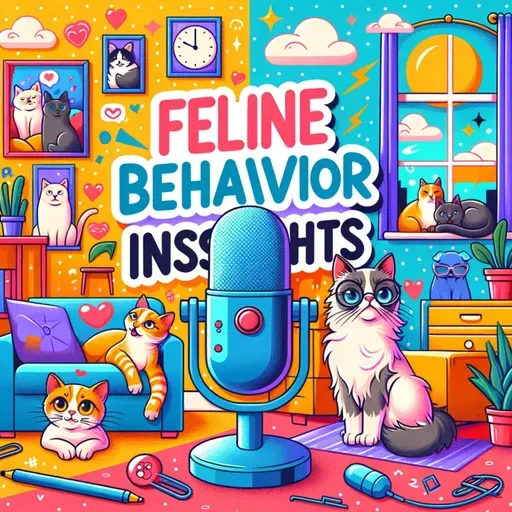
15 September 2025
Decoding Feline Behavior: Unlocking the Secrets of Cats' Body Language, Vocalizations, and Emotional Cues.
Feline Behavior Insights
About
Feline behavior is a fascinating puzzle, shaped by instincts, emotions, and nuanced communication. According to Wikipedia, cats express themselves through body language, elimination habits, aggression, play, grooming, and unique vocalizations. Understanding these cues helps listeners decode what their feline companions are thinking and feeling, deepening the bond between species.
One of the most expressive elements in a cat’s repertoire is its tail. As PetMD explains, a tail held high with a gentle curl at the tip signals happiness and confidence. Rapid tail flicking can mean the opposite: agitation or annoyance. During play, an animated tail in an upside-down U hints at excitement, while a tucked tail or puffed fur underscores fear or vulnerability. Ear positions also reveal emotional states, with erect ears marking a relaxed or curious cat and flattened ears indicating concern or potential aggression.
A cat’s eyes offer another window into its mind. Slow blinking between cats, often called the “cat kiss,” is a delicate display of trust and affection. Direct, unblinking eye contact, however, may signal a territorial challenge, especially between unfamiliar or rival cats.
Cats use their bodies to forecast intentions, as Tuft & Paw highlights. A relaxed cat might sprawl belly-up, displaying vulnerability and trust. This is not always an invitation for a belly rub, but it does mean the cat feels safe. Conversely, a slinking posture with a low belly and taut legs signals tension. Sometimes, cats use body blocking or stare-downs to assert control over prized resources or spaces, which can escalate to chasing or other signs of social conflict.
Vocalizations add another layer to feline communication. While cats do meow at humans for attention, among themselves they favor trills, growls, and hisses. These sounds convey everything from greetings to warnings, punctuating their silent language of postures and glances.
Play is also central to feline life. Cats simulate hunting by crouching, rear-end wiggling, and pouncing, often flicking their tails in anticipation. According to PetMD, providing toys assists with healthy physical and mental enrichment, channeling these natural instincts in a safe and beneficial way.
Finally, it’s worth mentioning that a cat’s stress is visible in stiff, tense body language, wide or narrowed eyes, rotated ears, and thumping tails. Listeners who notice these signs should try to identify and remove any sources of discomfort, ultimately focusing on building a trusting and harmonious home.
Thank you for tuning in and be sure to subscribe for more feline insights. This has been a quiet please production, for more check out quiet please dot ai.
For more http://www.quietplease.ai
Get the best deals https://amzn.to/3ODvOta
One of the most expressive elements in a cat’s repertoire is its tail. As PetMD explains, a tail held high with a gentle curl at the tip signals happiness and confidence. Rapid tail flicking can mean the opposite: agitation or annoyance. During play, an animated tail in an upside-down U hints at excitement, while a tucked tail or puffed fur underscores fear or vulnerability. Ear positions also reveal emotional states, with erect ears marking a relaxed or curious cat and flattened ears indicating concern or potential aggression.
A cat’s eyes offer another window into its mind. Slow blinking between cats, often called the “cat kiss,” is a delicate display of trust and affection. Direct, unblinking eye contact, however, may signal a territorial challenge, especially between unfamiliar or rival cats.
Cats use their bodies to forecast intentions, as Tuft & Paw highlights. A relaxed cat might sprawl belly-up, displaying vulnerability and trust. This is not always an invitation for a belly rub, but it does mean the cat feels safe. Conversely, a slinking posture with a low belly and taut legs signals tension. Sometimes, cats use body blocking or stare-downs to assert control over prized resources or spaces, which can escalate to chasing or other signs of social conflict.
Vocalizations add another layer to feline communication. While cats do meow at humans for attention, among themselves they favor trills, growls, and hisses. These sounds convey everything from greetings to warnings, punctuating their silent language of postures and glances.
Play is also central to feline life. Cats simulate hunting by crouching, rear-end wiggling, and pouncing, often flicking their tails in anticipation. According to PetMD, providing toys assists with healthy physical and mental enrichment, channeling these natural instincts in a safe and beneficial way.
Finally, it’s worth mentioning that a cat’s stress is visible in stiff, tense body language, wide or narrowed eyes, rotated ears, and thumping tails. Listeners who notice these signs should try to identify and remove any sources of discomfort, ultimately focusing on building a trusting and harmonious home.
Thank you for tuning in and be sure to subscribe for more feline insights. This has been a quiet please production, for more check out quiet please dot ai.
For more http://www.quietplease.ai
Get the best deals https://amzn.to/3ODvOta